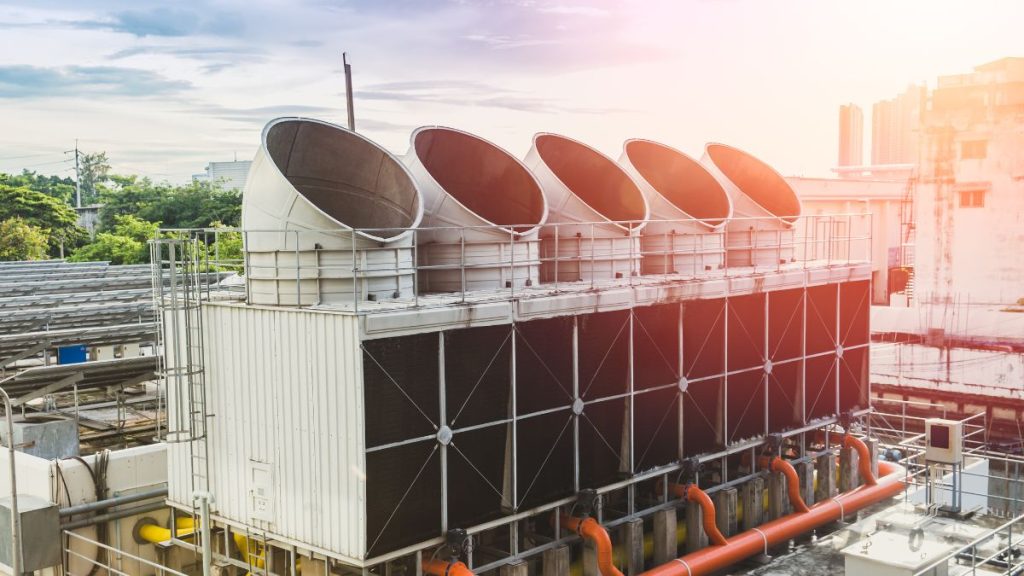Cooling towers are critical in many industrial and commercial operations, but they also create an ideal environment for microbial growth if not properly treated. Biocides in Cooling Tower systems are essential to control bacteria, algae, and fungi that can cause biofilm, corrosion, and even serious health risks like Legionella. Using the right biocides ensures efficient operation, extends equipment life, and safeguards worker safety.
The Role of Biocides in Cooling Tower
Cooling towers recirculate large volumes of water, making them particularly vulnerable to microbial contamination. Warm, nutrient-rich water creates an ideal environment for bacteria, algae, and fungi to thrive. If left untreated, this biological growth can lead to:
- Biofilm formation: Layers of microorganisms that stick to tower surfaces and reduce heat transfer efficiency.
- Clogged pipelines: Algae and bacterial growth that block water flow, increasing energy consumption.
- Corrosion and scaling: Microbiologically influenced corrosion (MIC) that damages metal surfaces and shortens equipment lifespan.
- Health hazards: Most notably, the risk of Legionella bacteria growth, which can cause Legionnaires’ disease, a severe form of pneumonia.
Biocides in cooling tower applications are specifically designed to control and eliminate these microbial threats. By incorporating biocides into a water treatment program, facility managers can:
- Maintain efficient heat exchange and reduce energy costs.
- Prevent unplanned downtime caused by fouling and corrosion.
- Protect workers and communities from harmful bacterial outbreaks.
- Extend the service life of cooling tower equipment.
In short, the role of biocides is central to ensuring that cooling towers operate safely, efficiently, and within regulatory compliance.
Read Also: Common Cooling Water Tower Problems and Solutions
What Are the Common Biocides in Cooling Towers?
The choice of biocide depends on factors such as water quality, operating conditions, regulatory requirements, and microbial load. In cooling tower systems, the two broad categories of biocides are oxidizing biocides and non-oxidizing biocides. Both types are often used in combination for optimal effectiveness.
1. Oxidizing Biocides
Oxidizing biocides are the most common in cooling tower treatment programs. They work by oxidizing cell components, disrupting microbial metabolism, and ultimately destroying microorganisms.
Common oxidizing biocides include:
- Chlorine – Widely used due to its effectiveness and cost efficiency. Chlorine is fast-acting but requires careful monitoring of pH levels.
- Bromine – More stable than chlorine in high-pH systems and highly effective against algae and bacteria.
- Chlorine dioxide – Known for strong oxidizing power, effective against biofilm and Legionella, and works in a broader pH range.
- Ozone – A powerful oxidant with quick action, though less commonly used due to cost and safety considerations.
These biocides are generally used for continuous dosing or shock treatment to maintain microbial control.
2. Non-Oxidizing Biocides
Non-oxidizing biocides target microorganisms through chemical interactions rather than oxidation. They are typically used as a supplement to oxidizing biocides, especially when resistant microbes are present.
Common non-oxidizing biocides include:
- Isothiazolinones – Effective against bacteria and algae, commonly used as a secondary treatment.
- Glutaraldehyde – Works well against biofilm and resistant microorganisms.
- Quaternary Ammonium Compounds (Quats) – Control bacteria and slime but may require combination with oxidizing biocides for maximum effect.
- DBNPA (2,2-Dibromo-3-Nitrilopropionamide) – Fast-acting and effective in a wide pH range, though it degrades quickly.
Non-oxidizing biocides are often dosed intermittently, depending on microbial activity and system demand.
Read Also: Cooling Tower: Function, Types, and Maintenance Solutions
Difference Between Oxidizing and Non-Oxidizing Biocides
While both categories serve the same ultimate purpose—to control microbial growth—their mechanisms, applications, and advantages differ. Understanding these differences is essential for designing an effective cooling tower water treatment program.
| Aspect | Oxidizing Biocides | Non-Oxidizing Biocides |
| Mechanism of Action | Destroy microbes through oxidation of cell structures | Disrupt metabolic or reproductive functions via chemical reactions |
| Speed of Action | Fast-acting | Varies, often slower but effective against resistant strains |
| Application | Continuous dosing or periodic shock treatment | Intermittent dosing, often supplementary |
| Effective Against | Wide range of bacteria, fungi, algae, biofilm | Resistant microbes, specific strains, biofilm |
| pH Sensitivity | Some (e.g., chlorine) are sensitive to pH levels | Generally less pH dependent |
| Cost | Typically lower (chlorine, bromine) | Often higher due to specialized chemicals |
| Usage Strategy | First line of defense in microbial control | Complementary treatment to improve system performance |
The most effective cooling tower treatment programs usually combine oxidizing and non-oxidizing biocides. This integrated approach ensures broad-spectrum microbial control, reduces resistance buildup, and provides flexibility under varying system conditions.
Conclusion
Microbial growth in cooling towers is not just a technical issue. It directly impacts operational efficiency, equipment lifespan, and public health. Biocides in Cooling Tower play a vital role in preventing these problems by controlling bacteria, algae, fungi, and biofilm formation. Both oxidizing and non-oxidizing biocides are essential, and when applied strategically, they form a powerful defense against microbial contamination.
However, effective use requires expertise, monitoring, and tailored solutions. Lautan Air Indonesia stands ready to provide comprehensive biocide programs, system monitoring, and technical support to help industries operate their cooling towers safely and efficiently.
Contact Lautan Air Indonesia today to learn how our water treatment expertise and tailored solutions can optimize your cooling tower performance and protect your operations.



